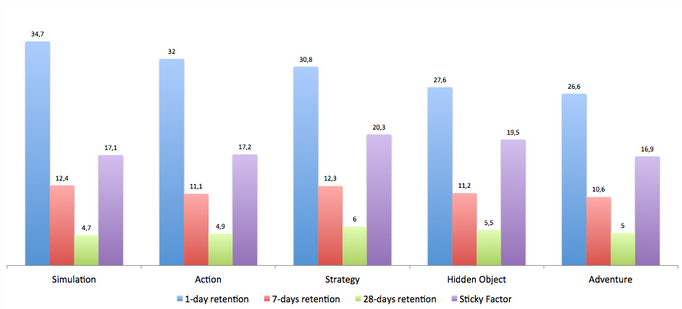If we compare the parameters of long-term retention, it turns out that two genres achieve the best results: strategy and hidden-object, – said in his article for App2Top.ru Vasily Sabirov, Leading Analyst devtodev.com .
At home in devtodev.com we have analyzed about 100 games of various genres. The following parameters were considered::
- 1-day retention;
- 7-days retention;
- 28-days retention;
- sticky factor (DAU/MAU).
The final analysis included 5 genres (we considered only those genres that included at least 10 games from our analysis):
- Action;
- Adventure;
- Hidden Object;
- Simulation;
- Strategy.
We have combined the results in a graph:
How can I comment on this graph?
We can compare one-day retention by genre and come to the conclusion that the maximum value is achieved in the Simulation (34.7%) and Action (32%) genres, and the minimum value is achieved in the Adventure genre (26.6%).
One-day retention is, as a rule, the user’s reaction to the game interface, the user’s understanding of the application. It is not surprising that simulators and action games, where you do not need to understand the game deeply, have a higher figure, and the complex adventure genre has a lower one.
However, if we compare not a one-day hold, but a 28-day hold, we will get different results.
The 28-day retention is characterized by the replayability of the application, and therefore it is understandable that the maximum value is achieved in strategies (6%) and games of the hidden object genre (5.5%). And simulators (4.7%) and action games (4.9%) have just low values – replay value is lower there.
Separately, you can analyze the ratio of a 28-day hold to a one-day hold. This indicator will characterize the probability of a user returning the next day after his first visit to stay in it for a long time. The results were as follows:
- Hidden Object – 19,9%;
- Strategy – 19,5%;
- Adventure – 18,8%;
- Action – 15,3%;
- Simulation – 13,5%.
Similar results are obtained by analyzing the sticky factor indicator – the maximum is also achieved there for strategies (20.3%) and games of the hidden object genre (19.5%). Sticky factor speaks about the regularity of user inputs, and we can say that this regularity can be achieved both by the depth of the game (in the case of strategies) and its casualness (hidden object).
Thus, we come to the conclusion that it is necessary to look not only at the one-day retention of the game, but also at the entire range of retention indicators (let’s call this a retention portrait).
A one-day indicator is certainly important for analyzing the effectiveness of the game (after all, they meet by clothes). However, a high value of one-day retention does not guarantee long-term success. Taking into account that games, as a rule, are focused on long-term interaction with the user, and the longer the user is in the project, the higher the probability of his conversion into a paying and average check, the sticky factor and long-term retention here become more significant than a one-day retention.
The key to maximizing these indicators will be the replayability of the game, which is achieved both by the depth of the game and the presence of many game layers in it, and by its casualness (low entry threshold).


